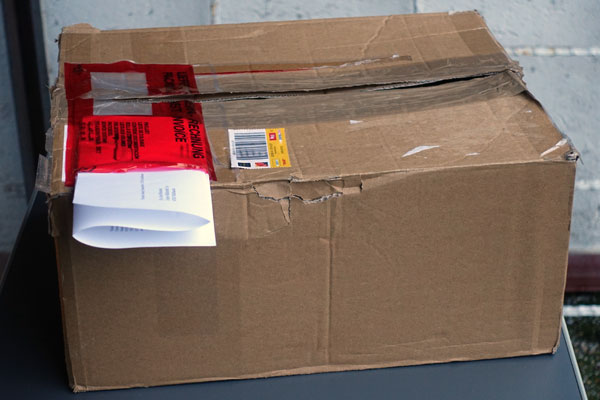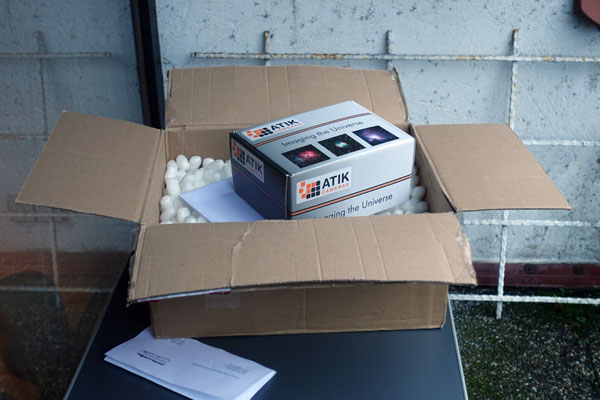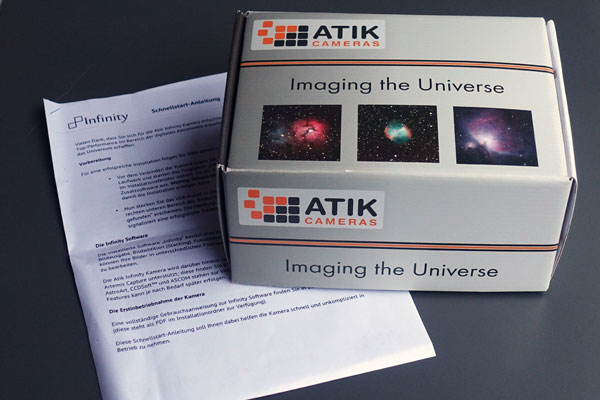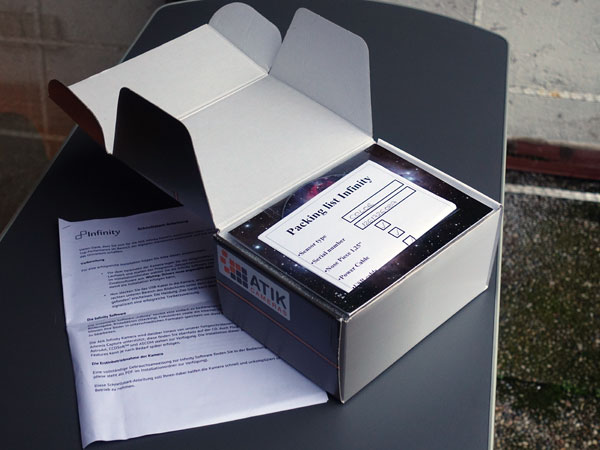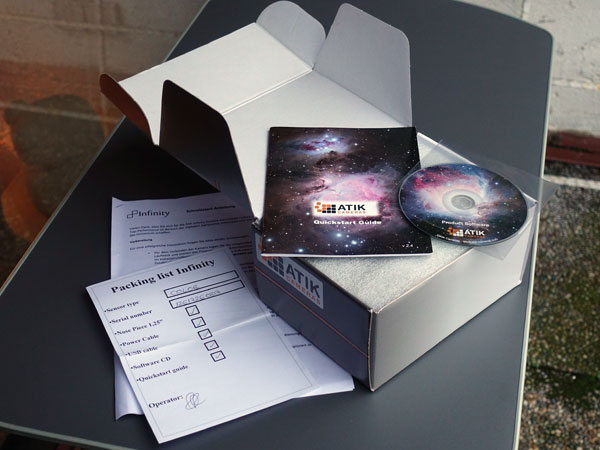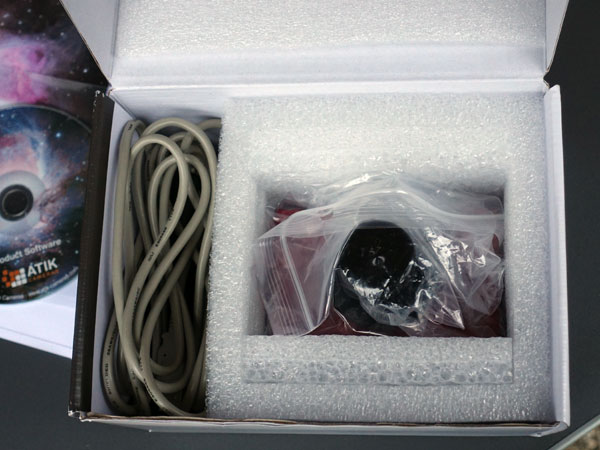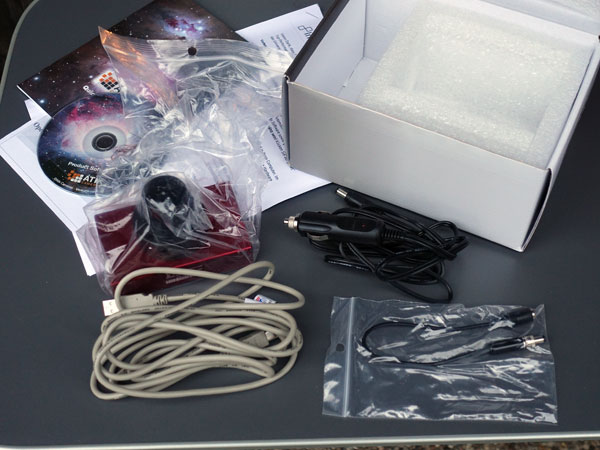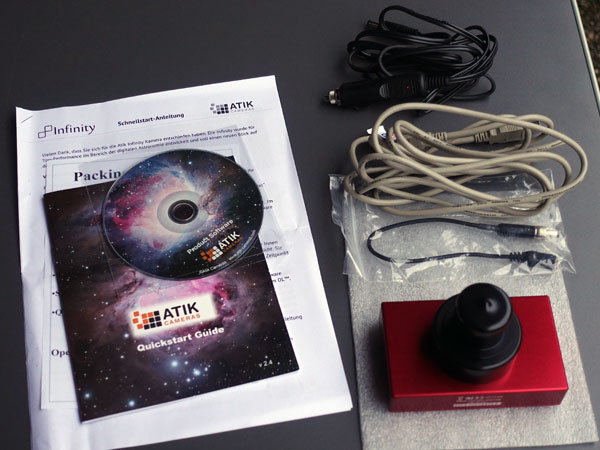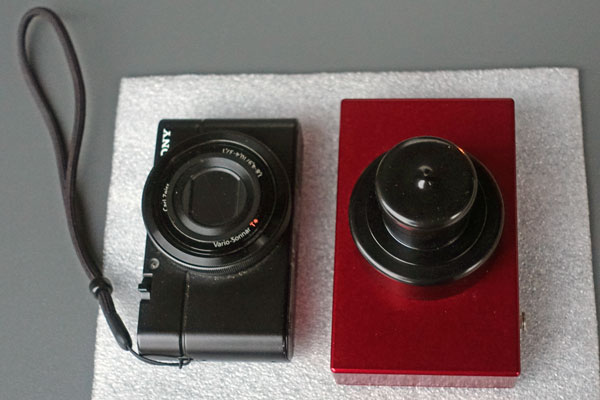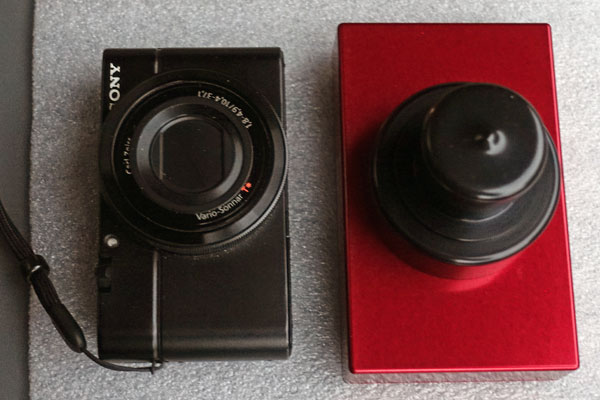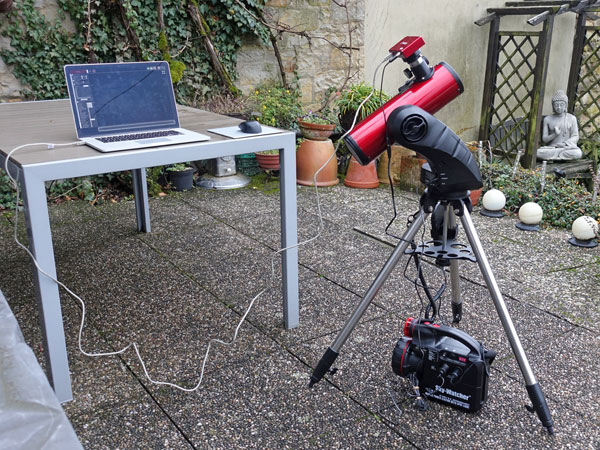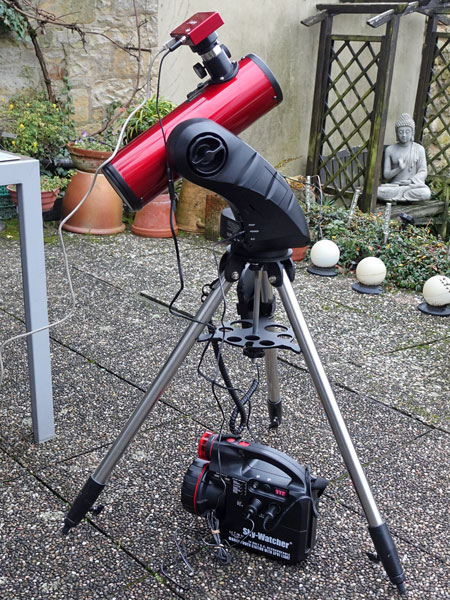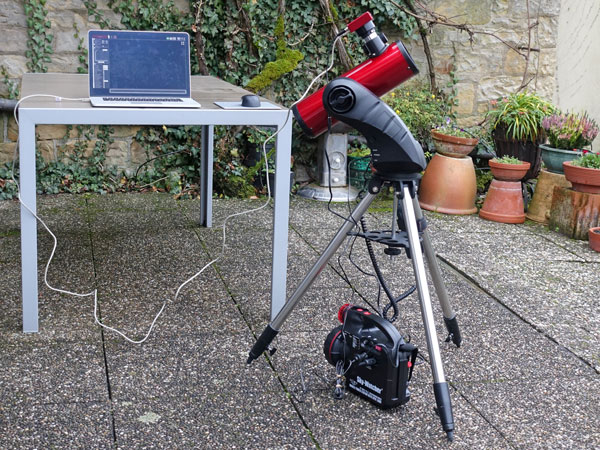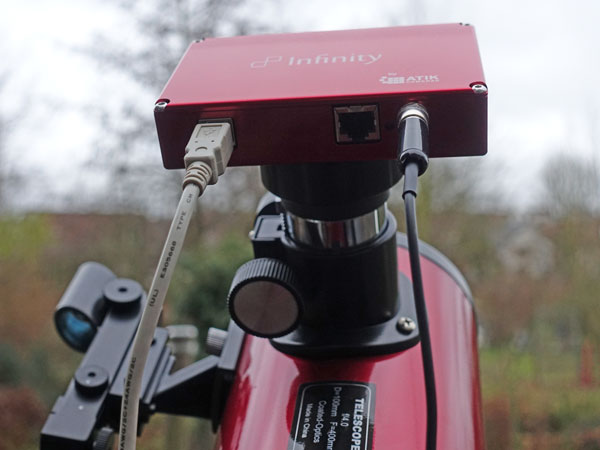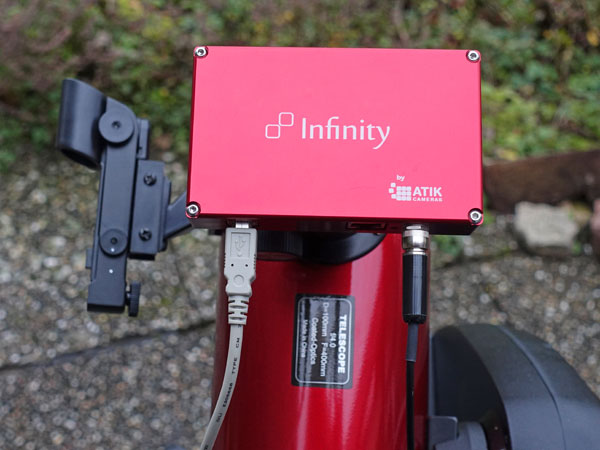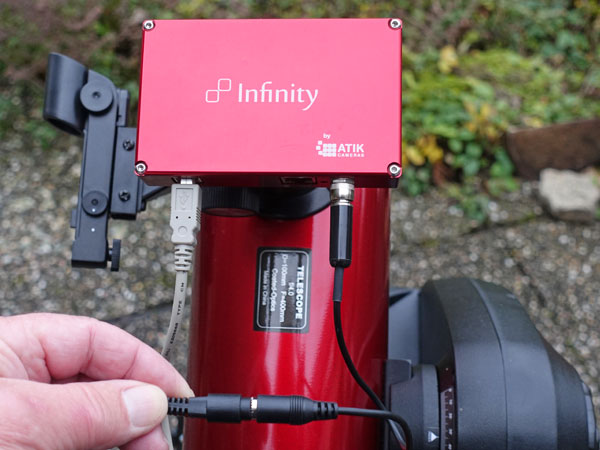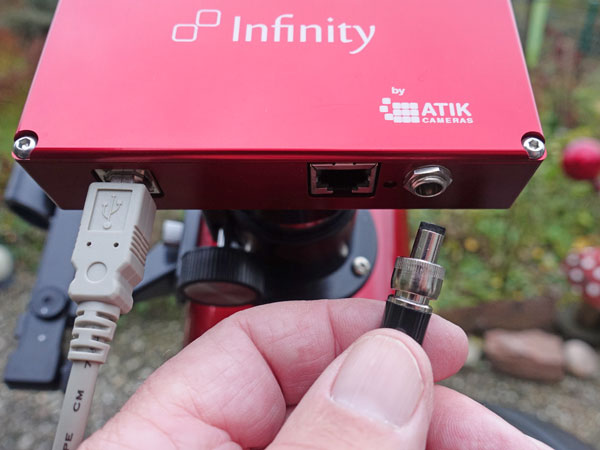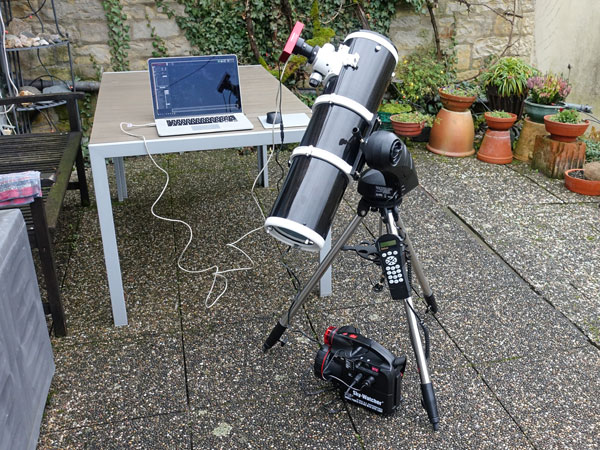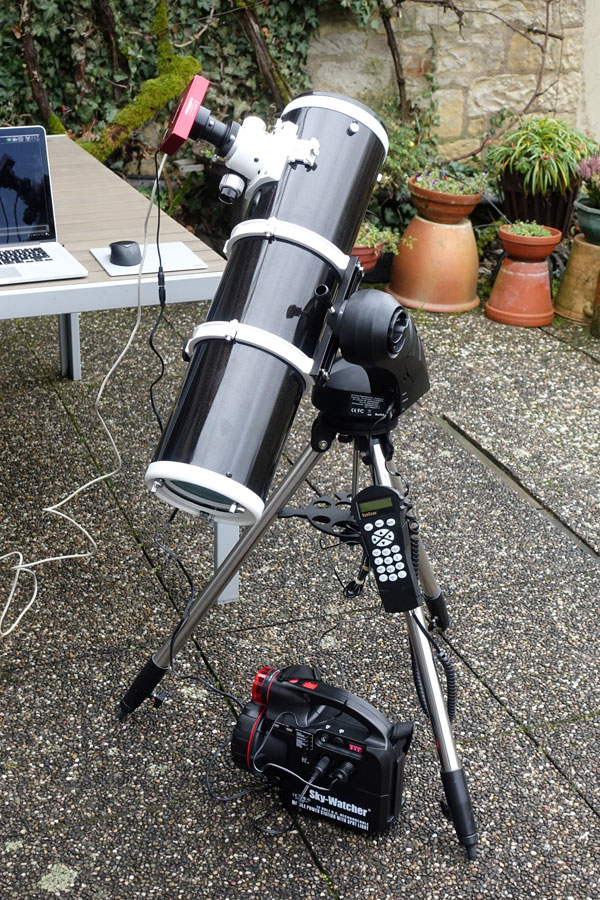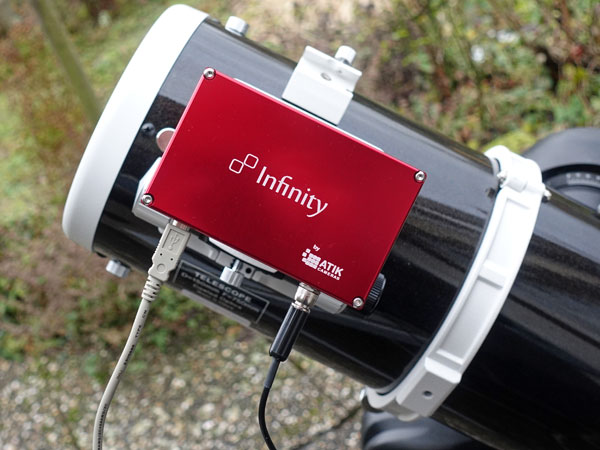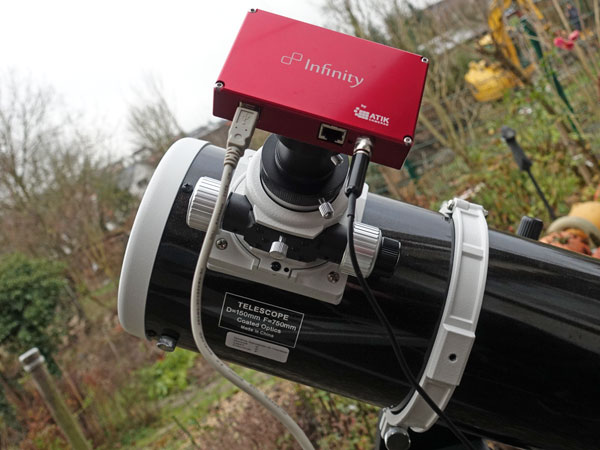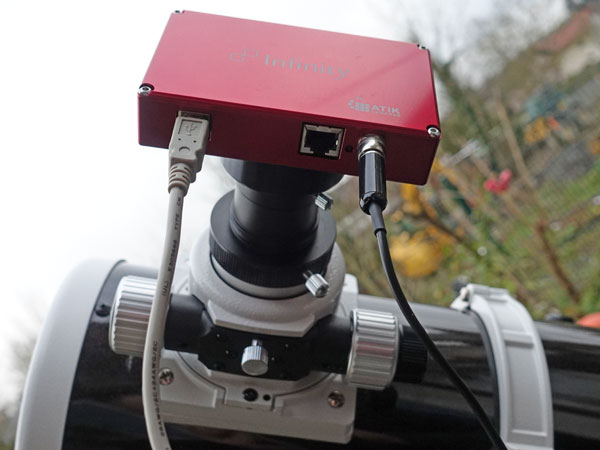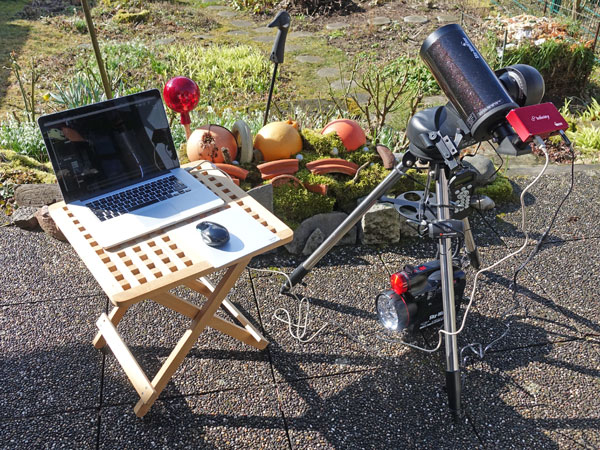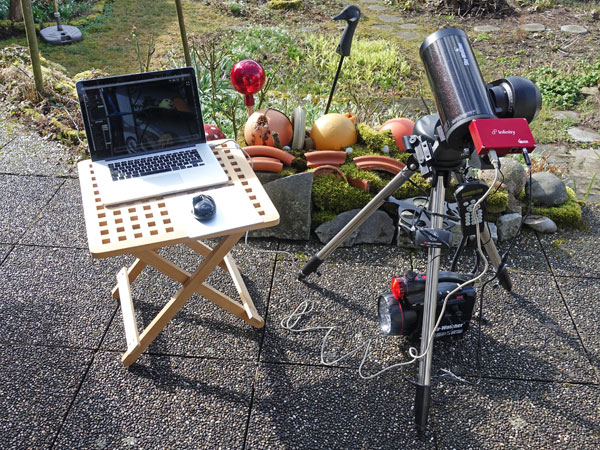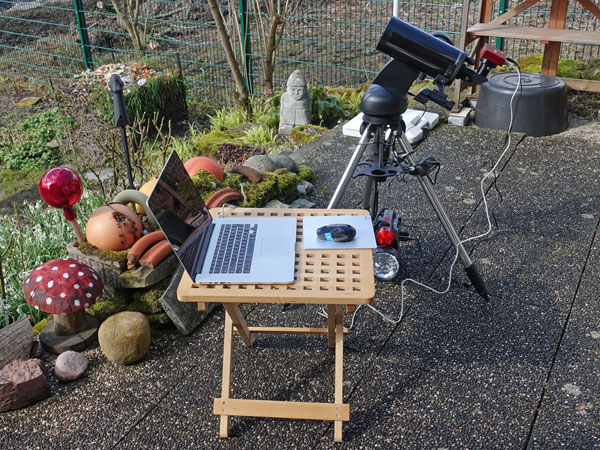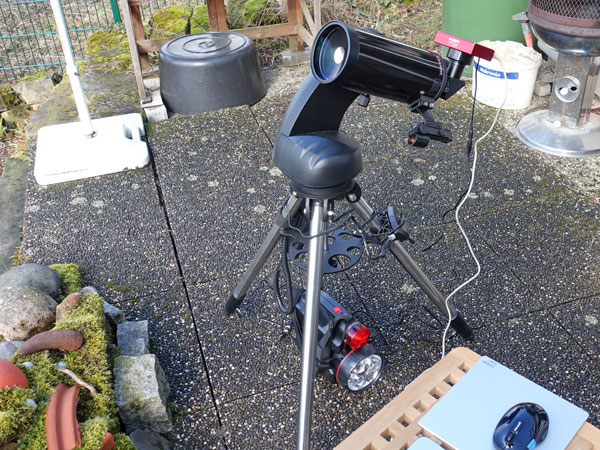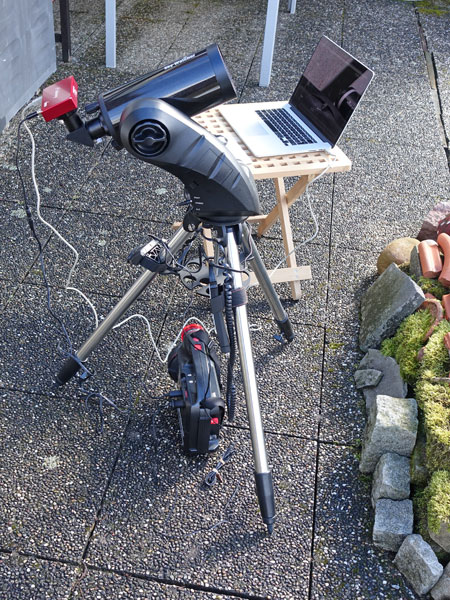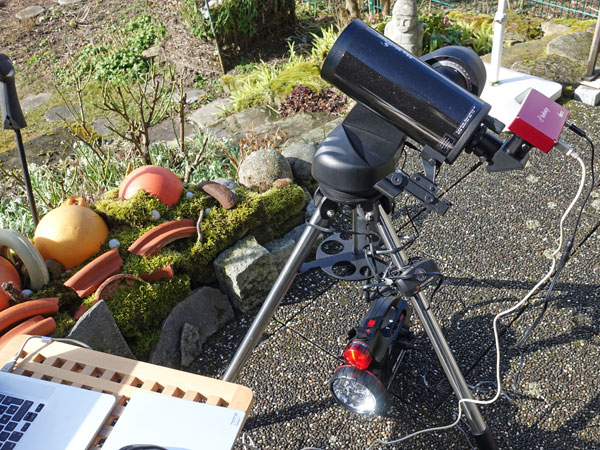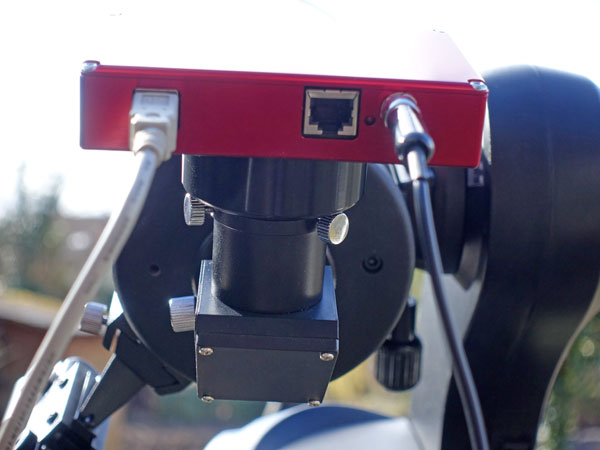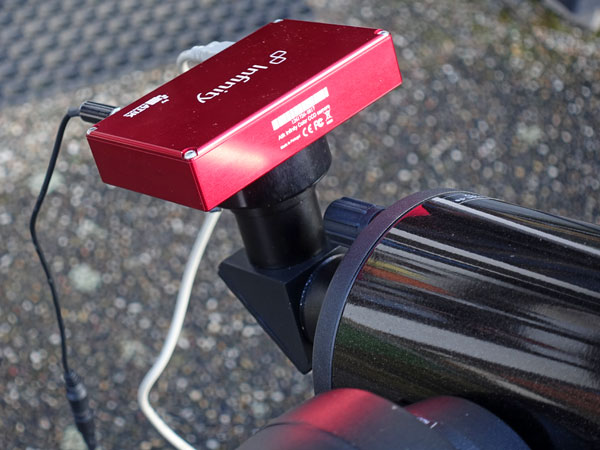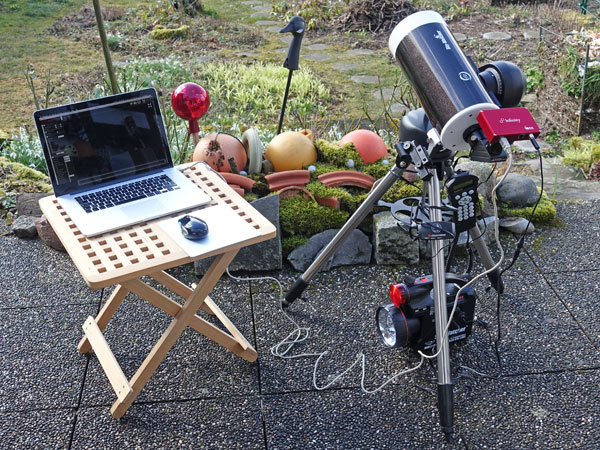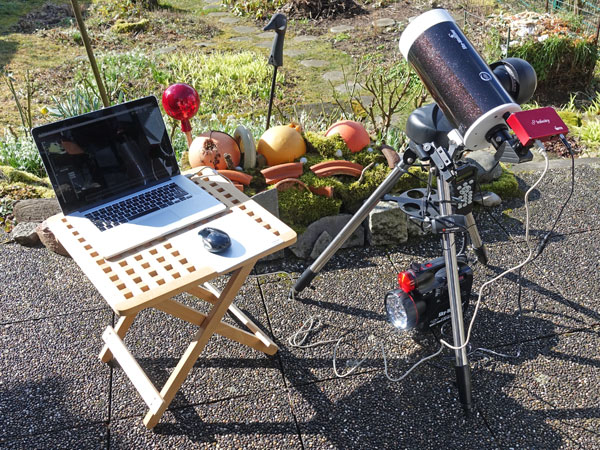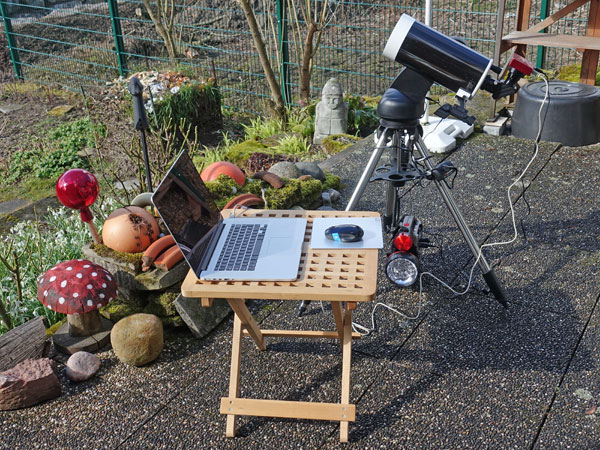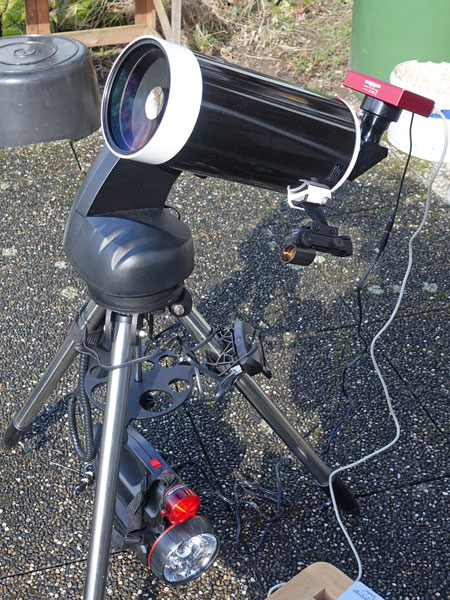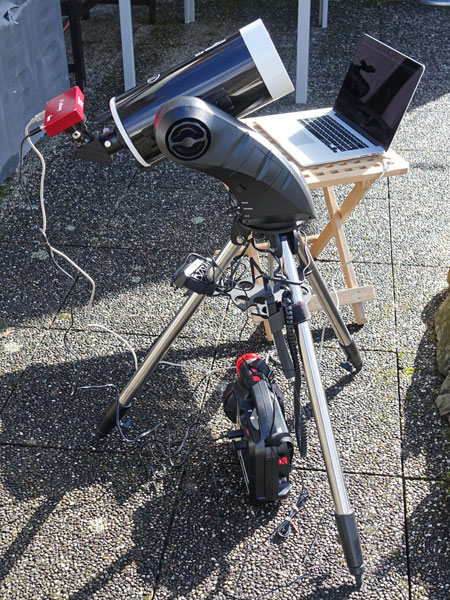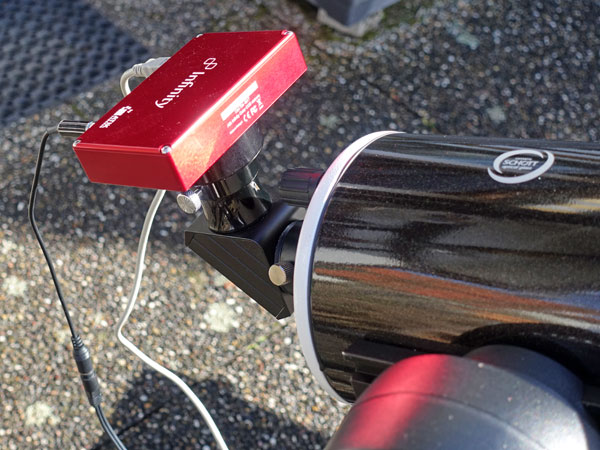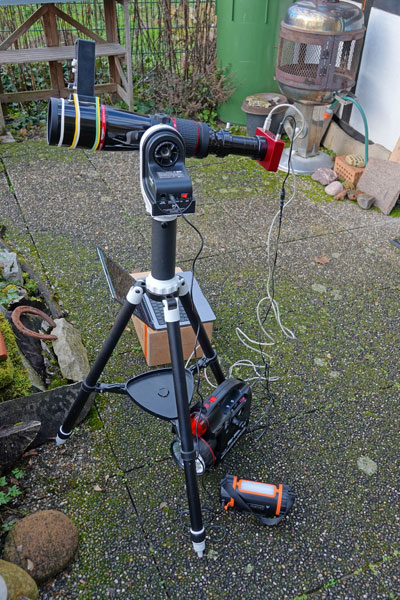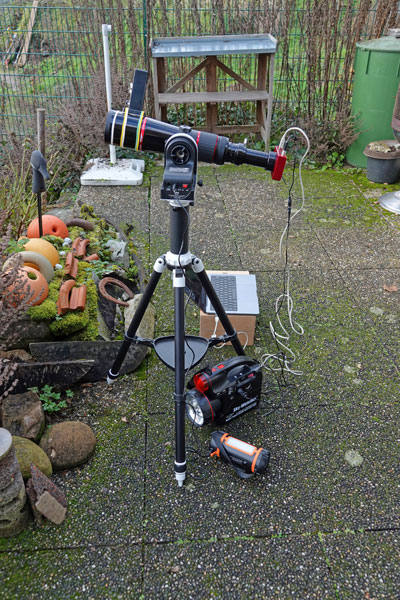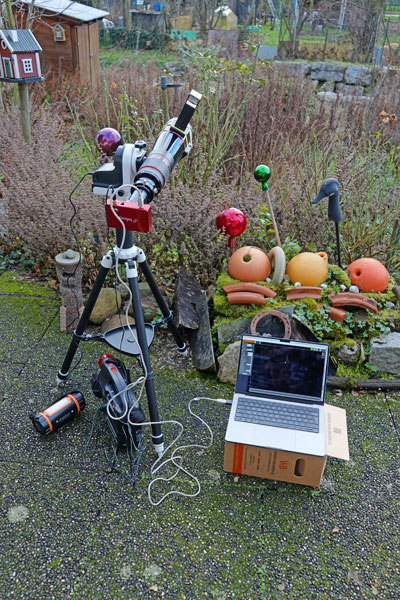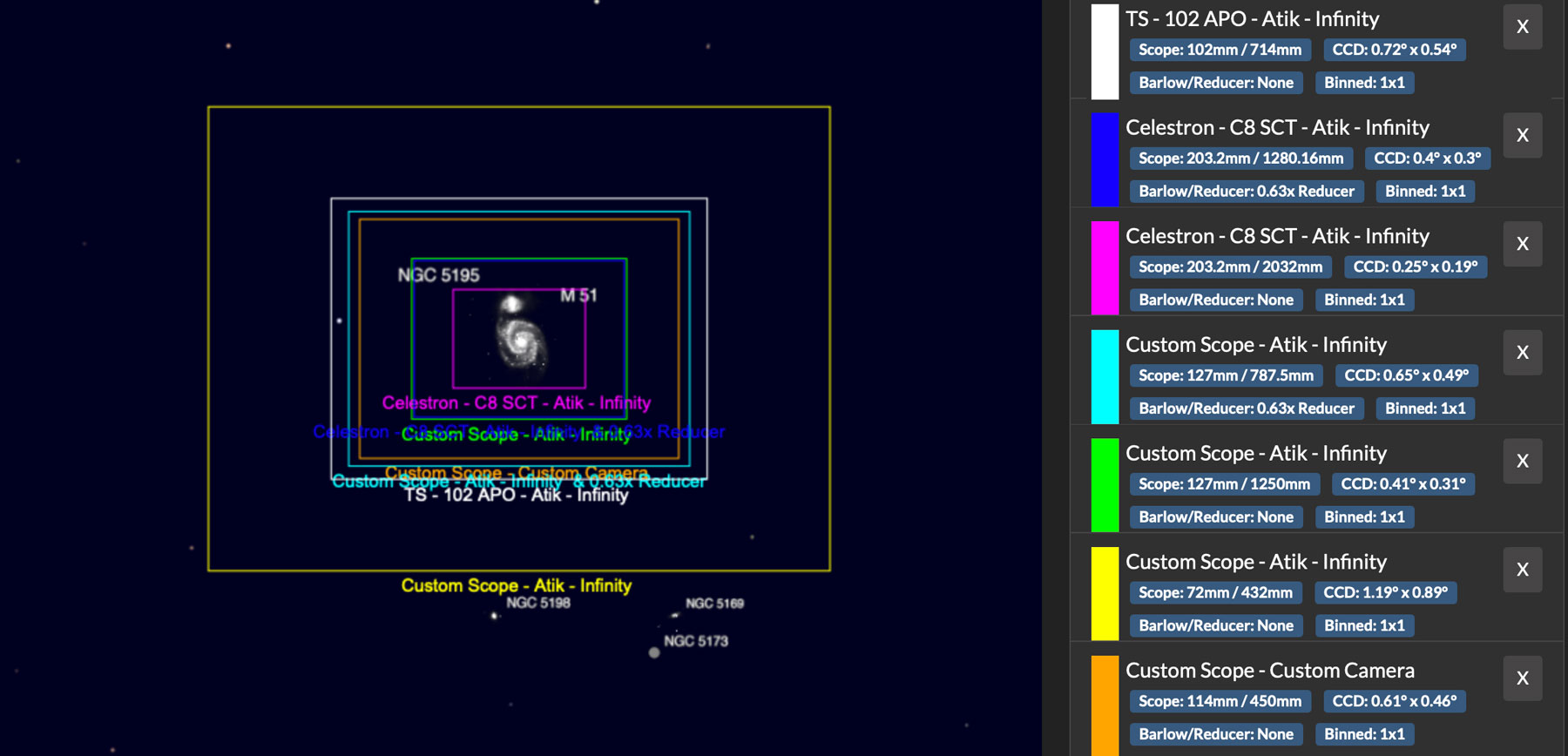Atik Infinity Colour Camera - Information
Look | Look at Different Telescopes | Sensor, Pixel Data, Field of View | Visited Sky Objects | First Photo Attempts | Early Conclusions | Links | Appendix: Data
Archive
On this page, I present some information about my Atik Infinity Colour* camera**. Possibly, this is useful for others who want to acquire this camera as well...
See also pages (Archive):
- Atik Infinity Colour Camera - Information
- Atik Infinity Colour Camera - First Experiences
- Atik Infinity Colour Camera - First Observation Sessions
- Atik Infinity Colour Camera - Further Experiences (Dry Runs) - Further Experiences (Nightly Tests)
- Atik Infinity Colour Camera - Software
- Atik Infinity Colour Camera - Field of View
- Atik Infinity Colour Camera - Photo Gallery
See the appendix for the data.
*) Usually, I would write "Color", because I try to use American
English, but Atik is a company located in the UK, and therefore it's "Colour"...
**) Received used on November 25, 2017 (see Notes below); sold at the end of December 2022, and finally transferred on January 5, 2023.
Note: Over Christmas 2022, I sold my Atik Infinity camera (transferred on January 5, 2023). I therefore cannot report any further experiences with it here. |
Notes
The Atik Infinity Colour camera is originally sold with the following accessories:
- 3-meter USB cable (printer cable)
- 1.8-meter battery power connector (12 V)
- Software CD, Quickstart guide (paper)
I bought the camera used at Teleskop-Leasing, instead of leasing it at first. They also supplied an adapter cable for the power supply that can be screwed into the camera und thus prevents the power cable from being removed inadvertently.
Look
Unboxing...
Note: Since this is a used camera, the package may not be in its original state...
|
Package and delivery note |
Package opened, camera box and quickstart guide moved to top |
Camera box and quickstart notes |
|
Camera box opened, the packing list lies on top |
Then the software CD and the Quickstart guide come... |
After removing the plastic cover, you can see the camera |
|
View of camera and cables (the original bags are gone...) |
Everything taken out of the box; at the bottom right you can see the additional cable adapter for the power supply |
Everything without box ... |
Look of the Camera
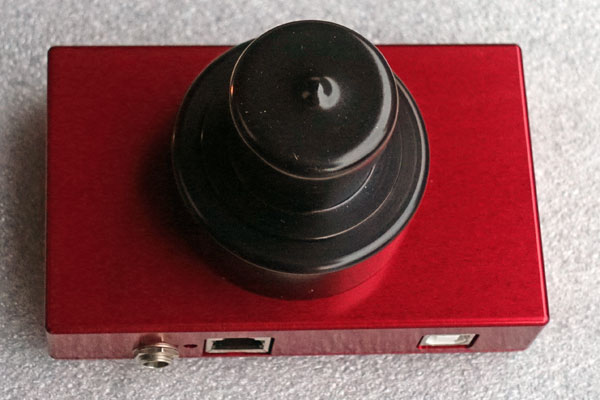 |
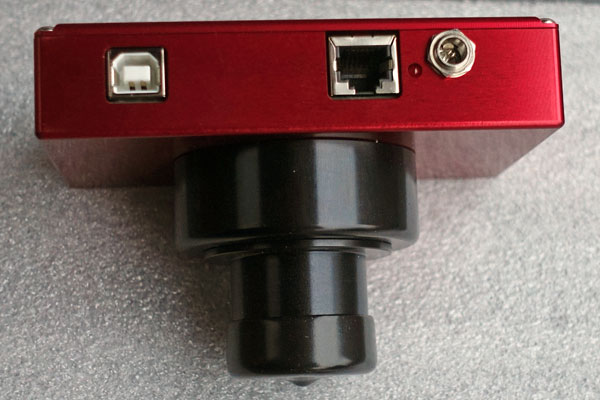 |
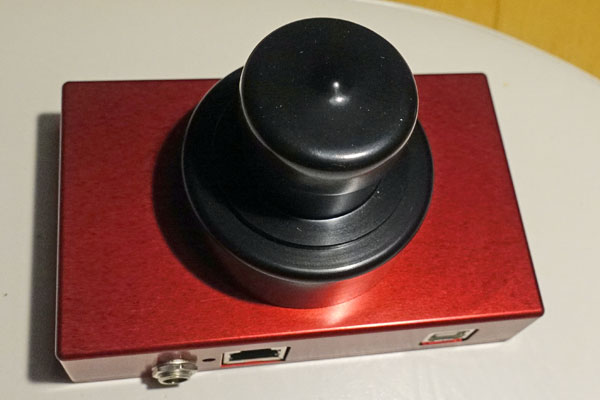 |
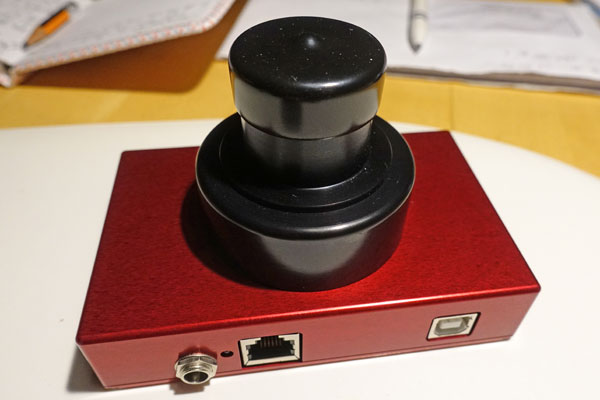 |
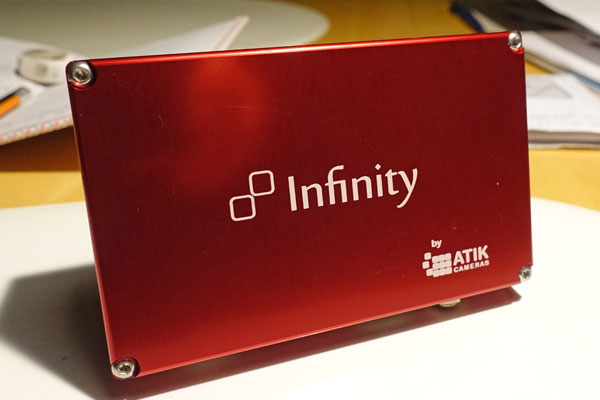 |
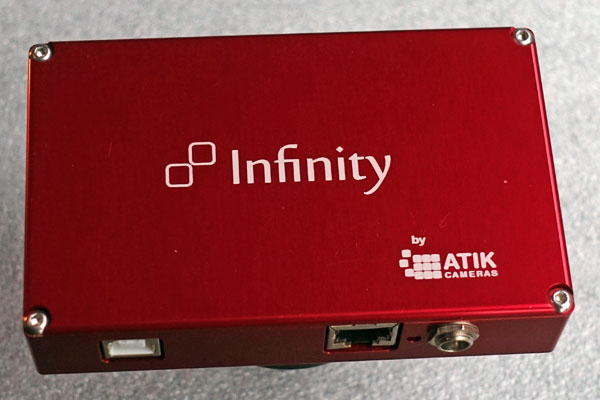 |
Size Comparison with Sony RX100 M1
|
Sony RX100 M1 and Atik Infinity |
Ditto |
Ditto |
Adapter Cable for the Power Cable
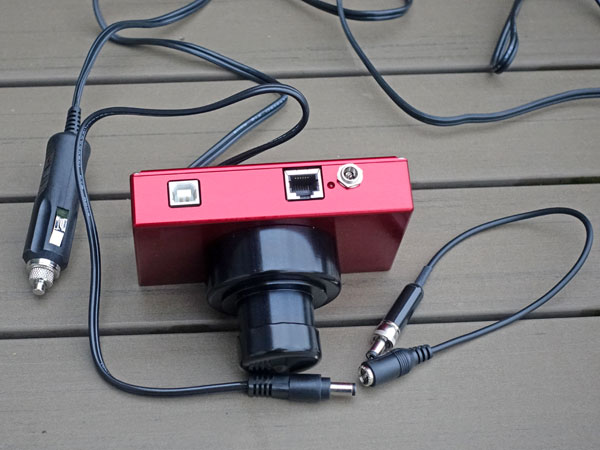 |
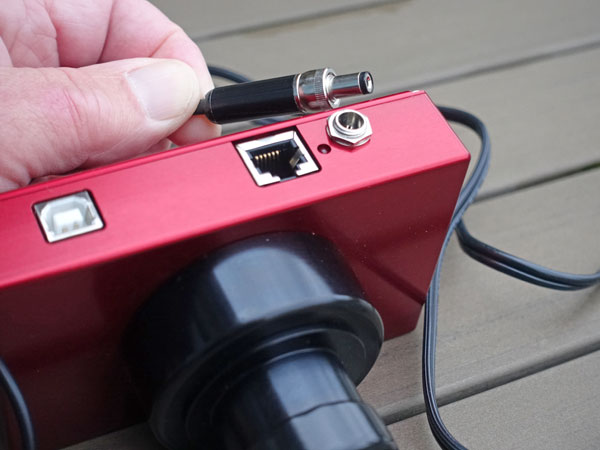 |
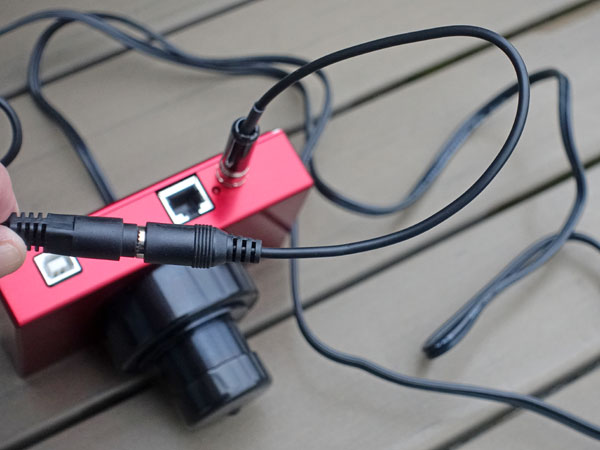 |
The adapter cable can be screwed into the power connector of the Atik Infinity camera, whereas the original power cable cannot.
Atik Infinity with Focal Reducer and Extension Sleeve (Sold)
TS 2 x Focal Reducer and 2.5 cm Extension Tube
 |
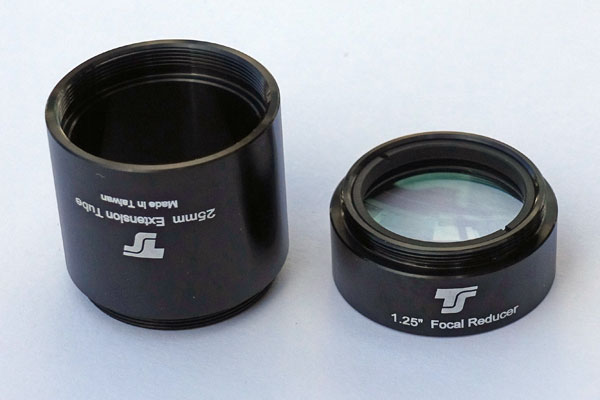 |
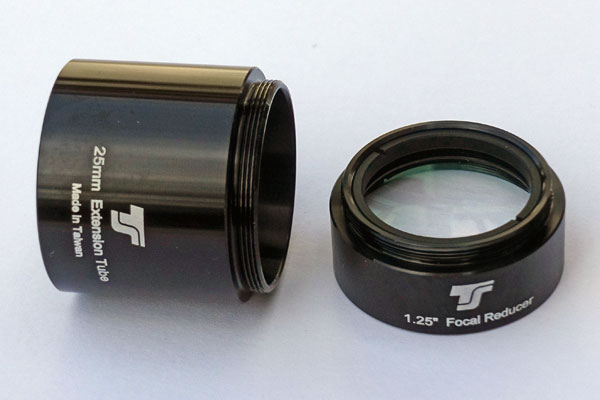 |
| TS focal reducer 2 x (right) and extension tube (left) | ||
TS 2 x Focal Reducer Fitted to Atik Infinity
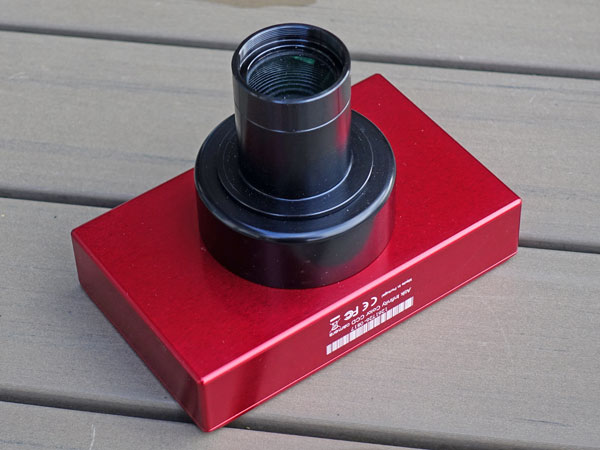 |
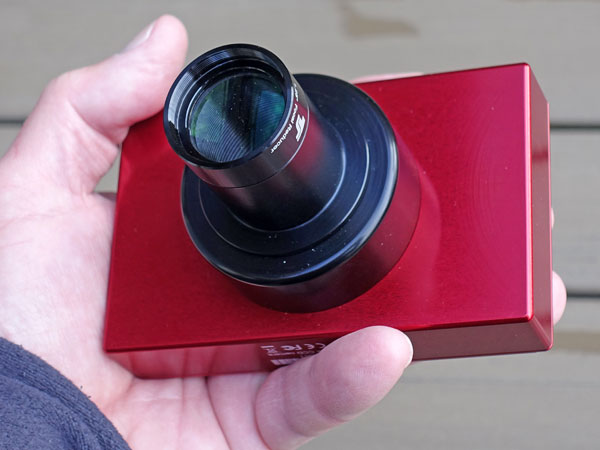 |
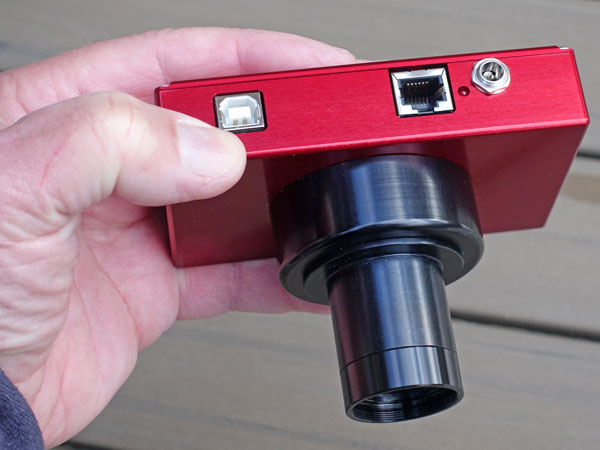 |
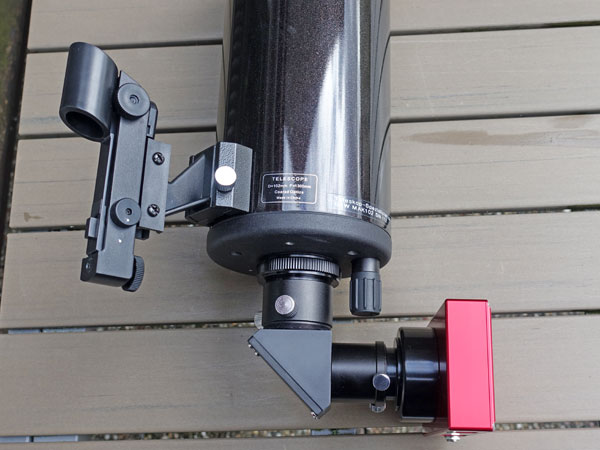 |
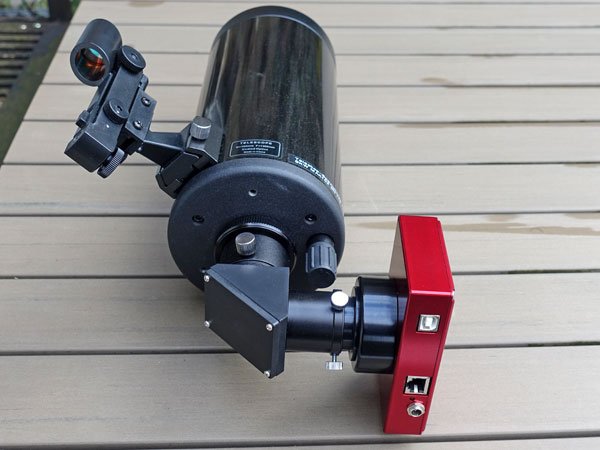 |
Attached to the Skymax-102 (not tested in practice - only at the Skymax-127) |
TS 2 x Focal Reducer and 2.5 cm Extension Tube Fitted to Atik Infinity
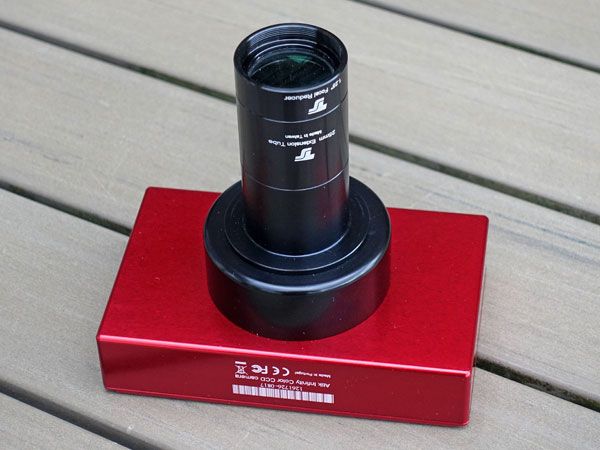 |
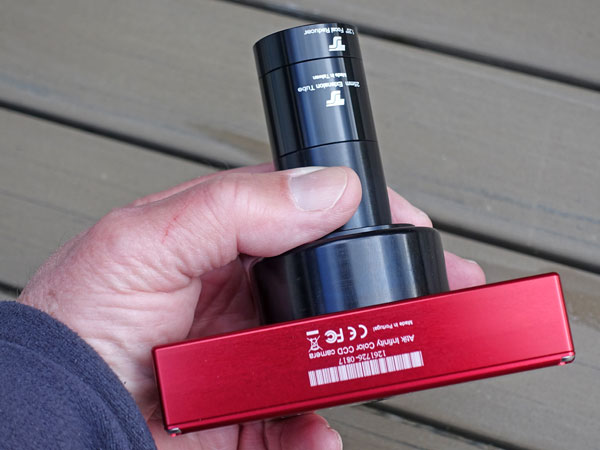 |
 |
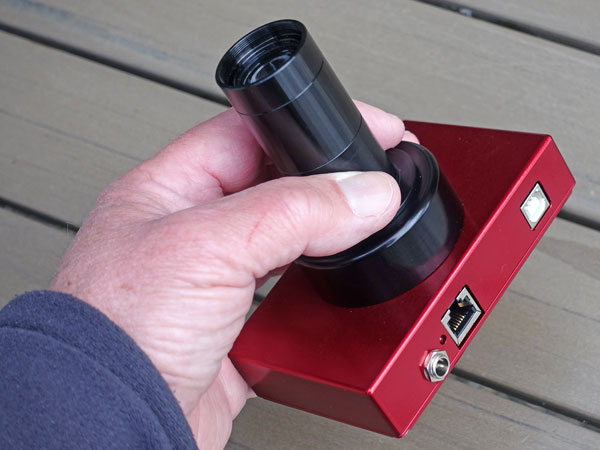 |
 |
 |
Look at Different Telescopes
Heritage 100P on Star Discovery AZ GoTo Mount
The Atik Infinity can be operated, from a purely technical point of view, at the Heritage 100P. Unfortunately, this combination does not work as such, because I cannot get into focus with the camera. But with a Barlow lens or a focal extender this is possible (tested with 2 x versions; not shown). In the meantime, I gave my Heritage 100P away.
| View of the complete equipment including the power pack (for the mount and the camera) and a laptop computer (for running the Atik Infinity software) | ||
Explorer 150PDS on Star Discovery AZ GoTo Mount
In the meantime, I sold my Explorer 150PDS.
Top left and center view
of the complete equipment including the power pack (for the mount and
the camera) and a laptop computer (for
running the Atik Infinity software) |
||
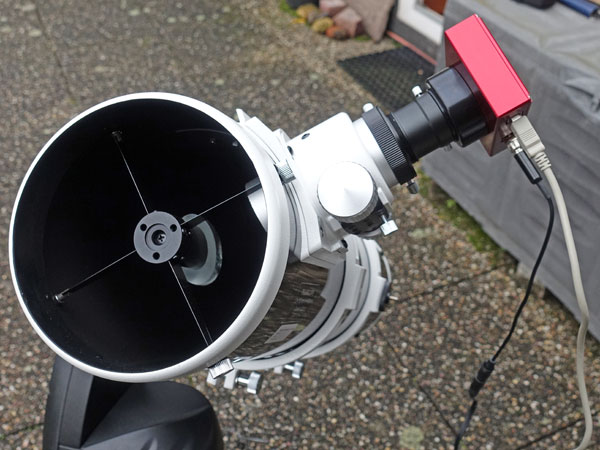 |
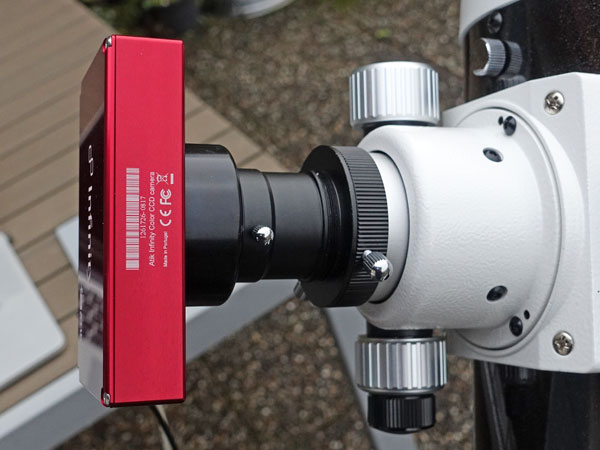 |
|
Skymax-102 on Star Discovery AZ GoTo Mount
The Atik Infinity can be operated at the Skymax-102. But because of the long focal length of the Skymax-102 and its small aperture ratio (1300 mm, f/12.7), a focal reducer is advisable (see above). I did not test this combination and sold the Skymax-102 in the meantime. Here the camera is shown without a focal reducer!
| View of the complete equipment including the power pack (for the mount and the camera) and a laptop computer (for running the Atik Infinity software) | ||
Skymax-127 on Star Discovery AZ GoTo Mount
The Atik Infinity can be operated at the Skymax-127. But because of the long focal length of the Skymax-127 and its small aperture ratio (1500 mm, f/11.8), a focal reducer is advisable (see above). I tested this combination with a 2 x TS focal reducer plus a 2.5 cm extension tube (nominally 3 x, but 2.31 x in practice). Here the camera is shown without a focal reducer!
| View of the complete equipment including the power pack (for the mount and the camera) and a laptop computer (for running the Atik Infinity software) | ||
Bye-Bye End of 2022 with PS 72/432
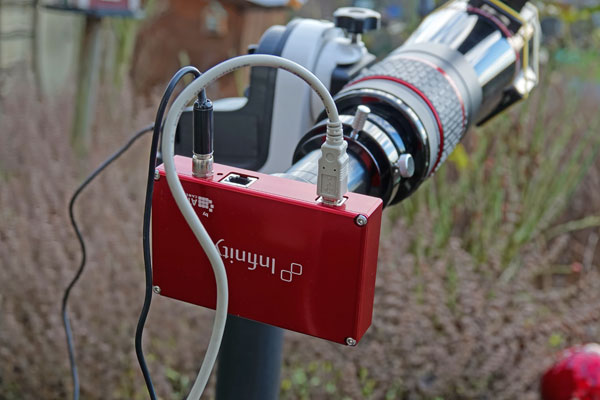 |
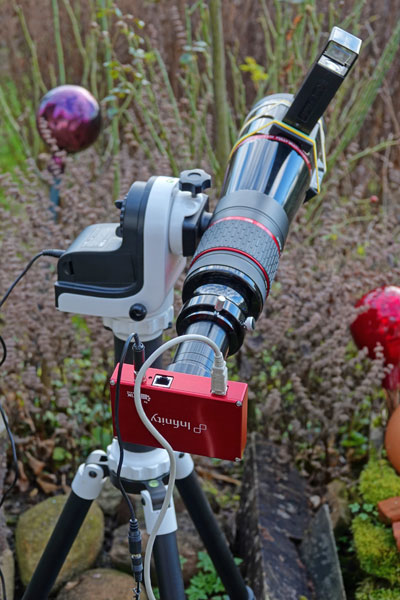 |
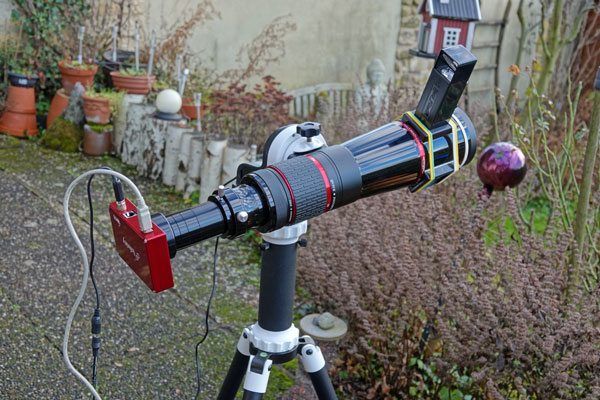 |
Sensor, Pixel Data, Field of View
The ASI224MC camera uses the Sony CCD sensor type Sony ICX825 (CCD) with a resolution of 1.4 MegaPixels, or 1392 x 1014 pixels (H/V). The pixel size is 6.45 µm (quadratic pixels). With this, all sizes are known to calculate the field of view of the camera at different telescope tubes!
On page Atik Infinity Colour Camera - Field of View, I make more comprehensive estimates of the field of view with my telescopes at that time. In the following, I simply use the Website astronomy.tools to determine the field of view of my current telescopes (as of April 2021) at the Atik Infinity:
Legend: Orange Custom Scope = eVscope; Yellow Custom Scope = PS 72/432
And here the same for the ZWO ASI224MC (it uses the same sensor as the eVscope):
Legend: Orange Custom Scope = eVscope; Red Custom Scope = PS 72/432
I summarize the results in the following table (I added the ASI294MC):
Field of View |
|||||||
| Telescope | Reducer | Focal Length | Aperture | ASI224MC* | Atik Infinity* | ASI294MC* | Remarks |
| PS 72/432 | --- | 432 | 72 | 0.65° x 0.48° | 1.19° x 0.89° | 2.54° x 1.73° | The largest FOV |
| C5 | --- | 1250 | 127 | 0.22° x 0.17° | 0.41° x 0.31° | 0.88° x 0.60° | FOV like C8 with reducer |
| C5 | f/6.3 | 787.5 | 127 | 0.36° x 0.17° | 0.65° x 0.49° | 1.40° x 0.95° | FOV a little smaller as with TLAPO1027 |
| C8* | --- | 2032 | 203 | 0.14° x 0.1° | 0.25° x 0.19° | 0.54° x 0.37° | The smallest FOV |
| C8* | f/6.3 | 1280 | 203 | 0.22° x 0.16° | 0.4° x 0.3° | 0.86° x 0.58° | FOV like C5 |
| TLAPO1027* | --- | 714 | 102 | 0.39° x 0.29° | 0.72° x 0.54° | 1.54° x 1.05° | FOV a little larger that for C5 with reducer |
| eVscope* | --- | 450 | 114 | 0.61° x 0.46 | --- | --- | Same chip as ASI224 |
Roughly simplified, the fields of view of the Atik Infinity are almost twice
as large per dimension, that is, the image areas are almost four times as large
as those of the ASI224MC. Since the chips have roughly the same numbers of pixels,
this difference is mainly due to the different pixel sizes (3.75 versus 6.45 µm). And compared with the ASI294MC, the fields of view of the Atik Infinity are almost half
as large per dimension.
*) No longer in my possession.
Visited Sky Objects
I visited (and documented) the following sky objects with the Atik Infinity camera:
- M 15, M 57 (with Heritage 100P)
- M 15, M 27, M 56, M 57 (with Heritage 100P and 2 x Barlow lens / 2 x focal extender)
- M 1, M 15, M 27, M 35, M 36, M 37, M 38, M 41, M 42/43, M 45, M 50, M 56, M 57, M 71, NGC 2264, Moon (Half Moon) (with Explorer 150PDS)
- M 31/32, M 45 (with Skymax-127 and 2 x focal reducer plus extension tube, that is, about 3 x reduction)
- M 15, M 42/43, NGC 2024 (with C8)
- M 42/43, M 78, NGC 1977, NGC 2024 (with PS 72/432)
- M 35, M 42/43, M 78, NGC 1977, NGC 2024 (with TLAPO1027)
- M 35, M 42/43, M 45, M 78 (with C5)
- M 1, M 31, M 35 (+ NGC 2158), M 36, M 37, M 38, M 42/43, M 51, M 65/66 und Leo-Triplett (mit NGC 3628), M 78, M 81, M 82, M 97, M 105, M 108, NGC 2244, NGC 2264 (mit PS 72/432, 2022)
See also page Atik Infinity Colour Camera - Photo Gallery for photos of the DSO.
First Photo Attempts
Notes: On this page, I only show successful first photo attempts. On page First Experiences, I present all of my first attempts, whereas on page Gallery, I will collect and present the, in my opinion, best photos.
Attempts on December 31, 2017
Photos taken with Explorer 150PDS on Star Discovery AZ GoTo mount:
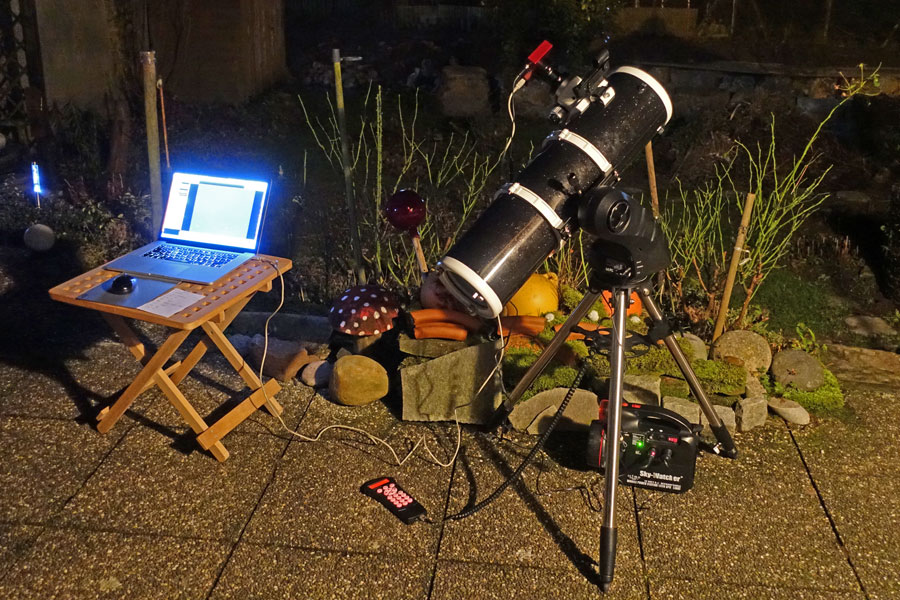 |
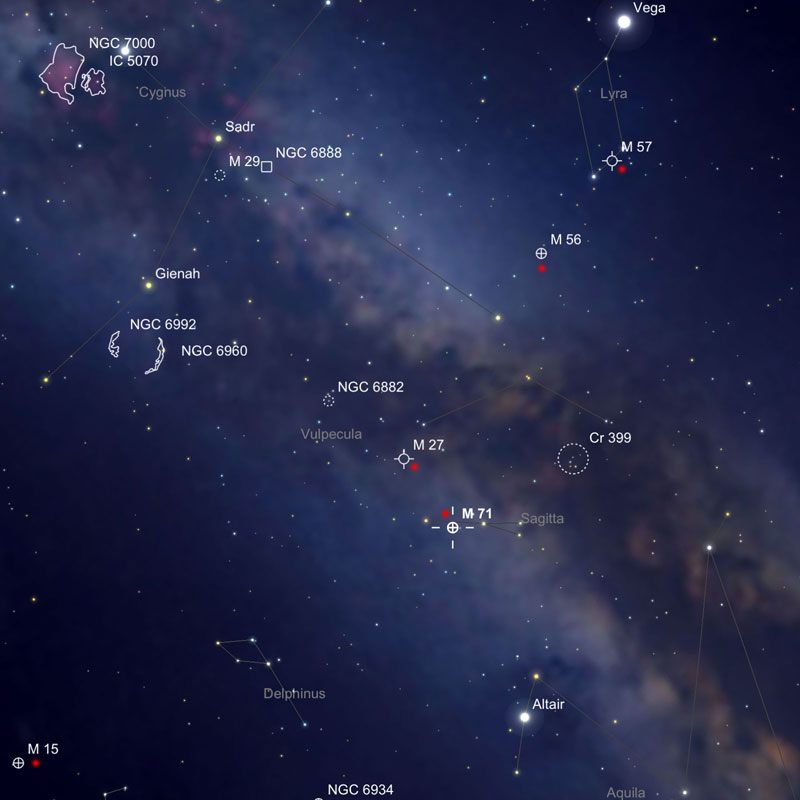 |
|
Photo: My test equipment |
Chart: Locations of the sky objects M 15, M 27, M 56, M 57, and M 71 (larger chart) |
The Photos
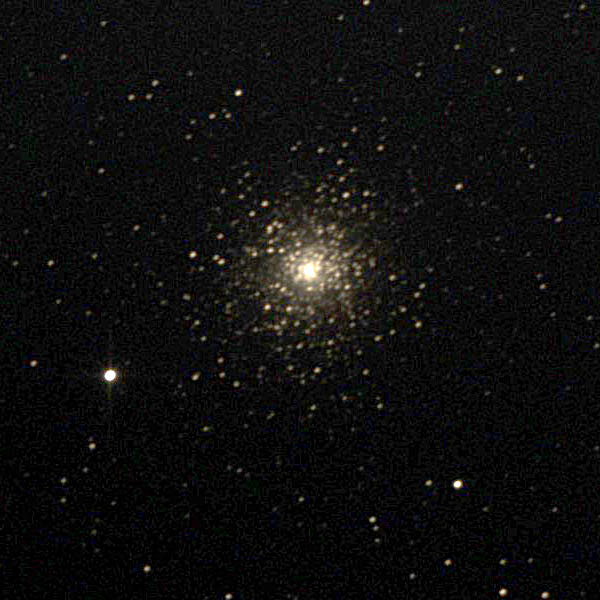 |
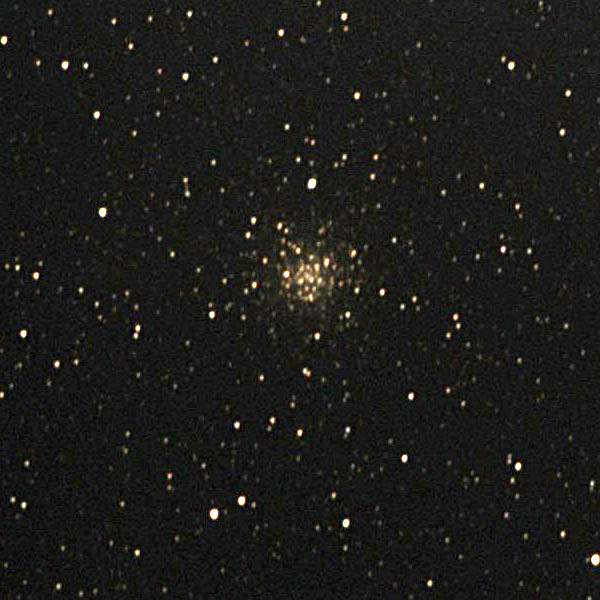 |
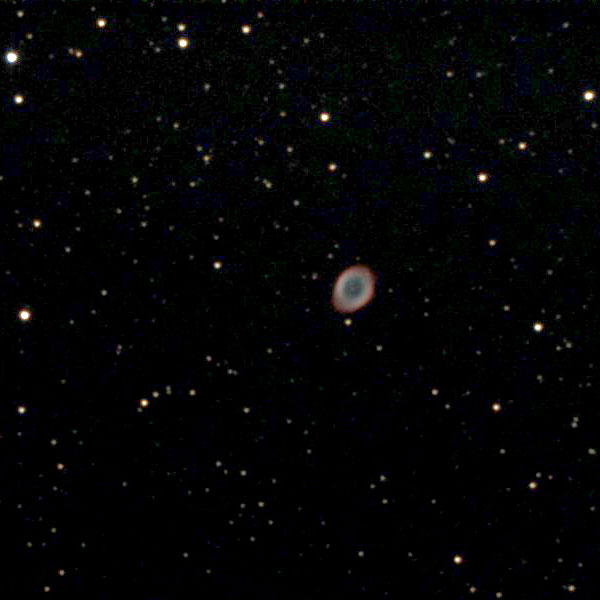 |
||
M 15 (Pegasus) |
M 56 (Lyra) |
M 57 (Ring nebula in Lyra) |
||
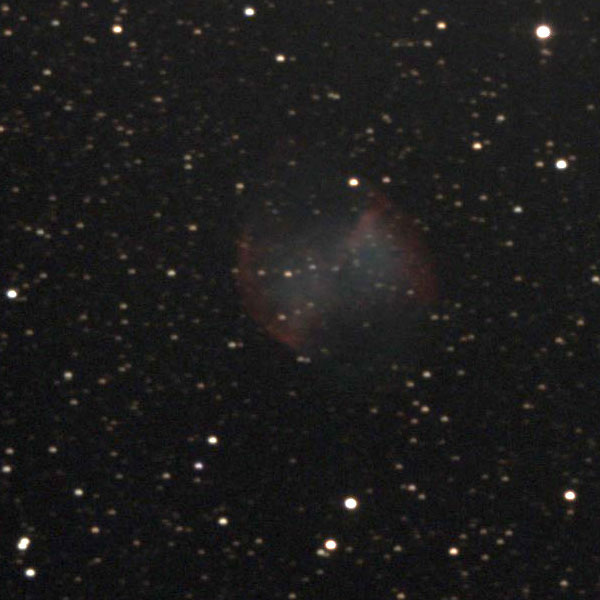 |
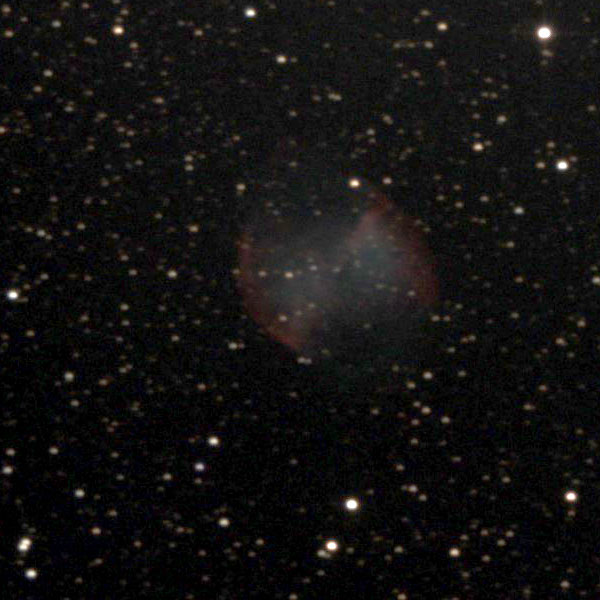 |
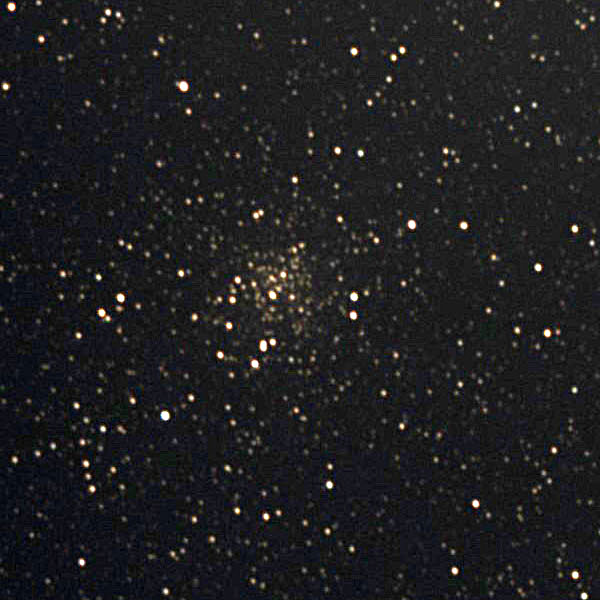 |
||
M 27 (Dumbbell nebula in Vulpecula) |
Ditto, alternative processing |
M 71 (Sagitta) |
Attempts on January 14, 2018
Photos taken with Skymax-127 and 2 x focal reducer plus 25 mm extension tube (results theoretically in about 3 x reduction, practically in about 2,31 x reduction) on Star Discovery AZ GoTo mount:
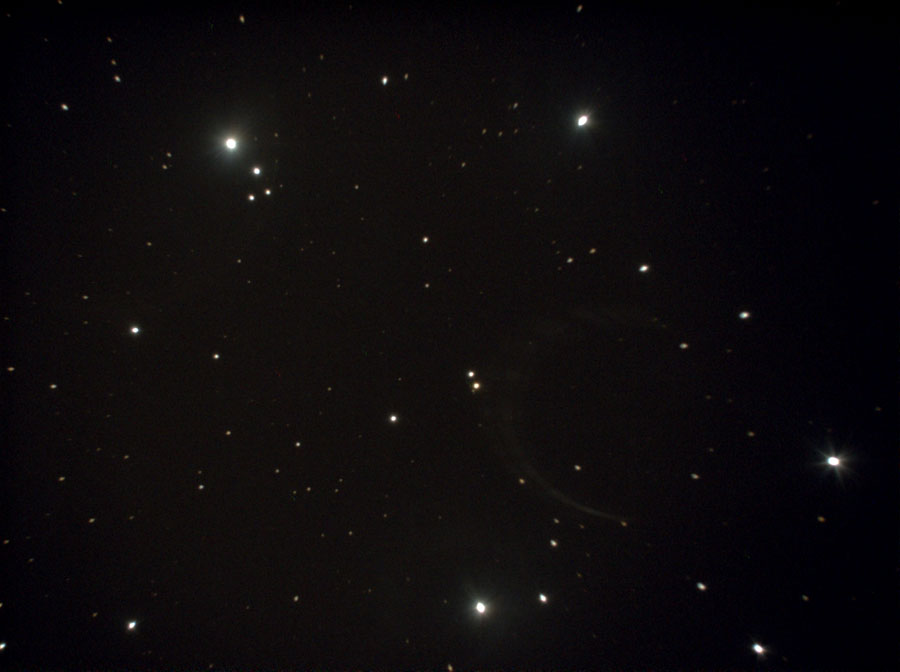 |
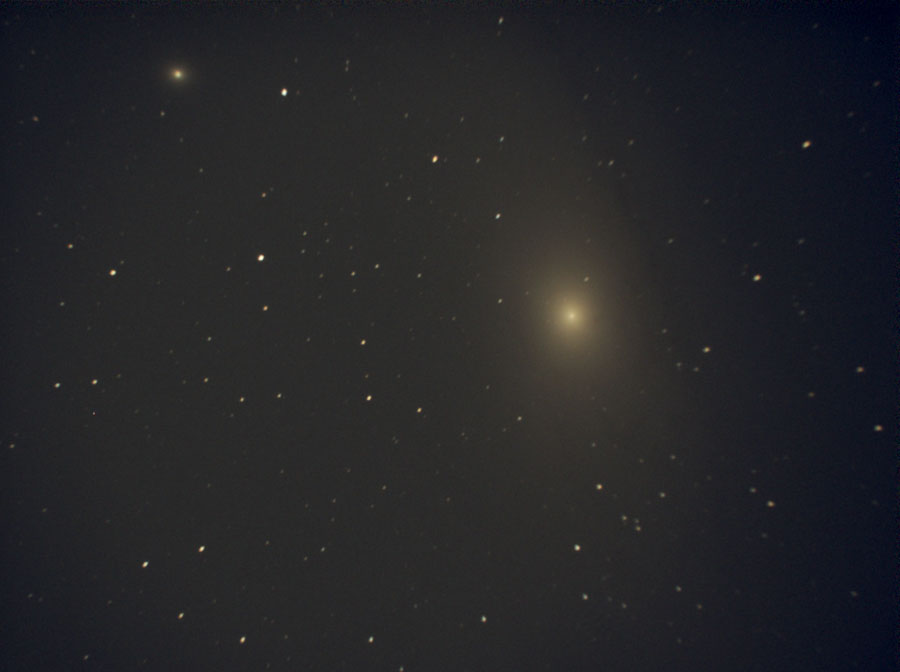 |
|
M 45 (Taurus), center |
M 31 and M 32 (top left, Andromeda) |
|
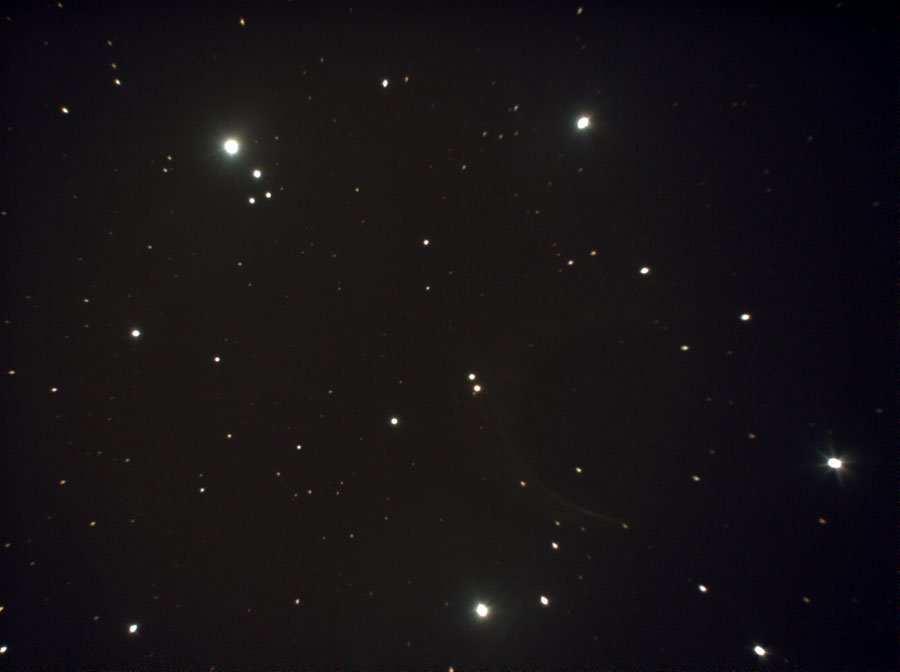 |
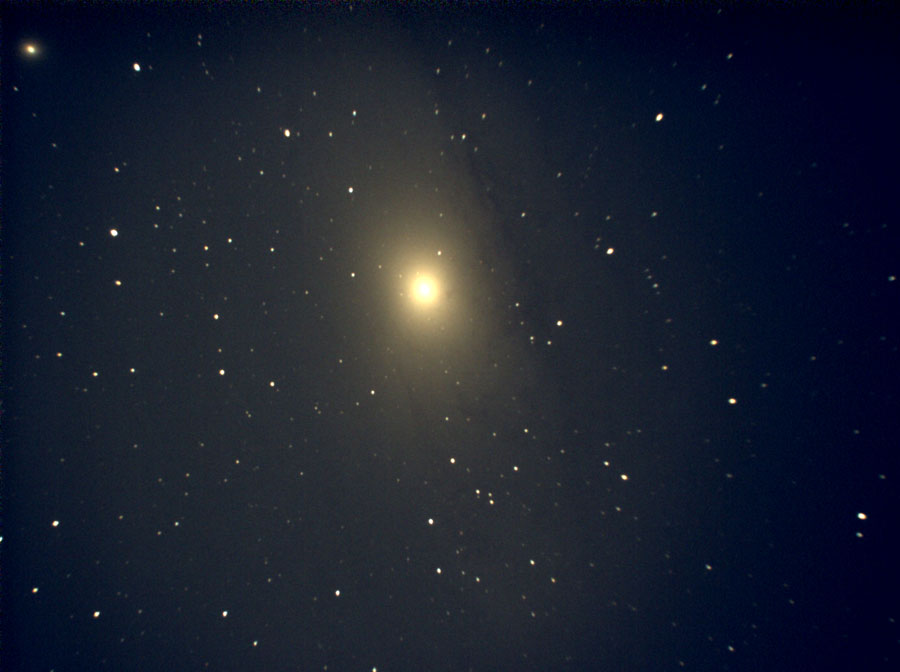 |
|
M 45 (Taurus), created from recording |
M 31 and M 32 (top left, Andromeda), created from recording |
Note that these photos show the complete image and that the large versions are in original size. This is due to the fact that the sky objects are extended - even beyond the field of view.
Attempts on February 12, 2018
The following photos were taken with the Explorer 150PDS on the Star Discovery AZ GoTo mount (with StarSense module):
 |
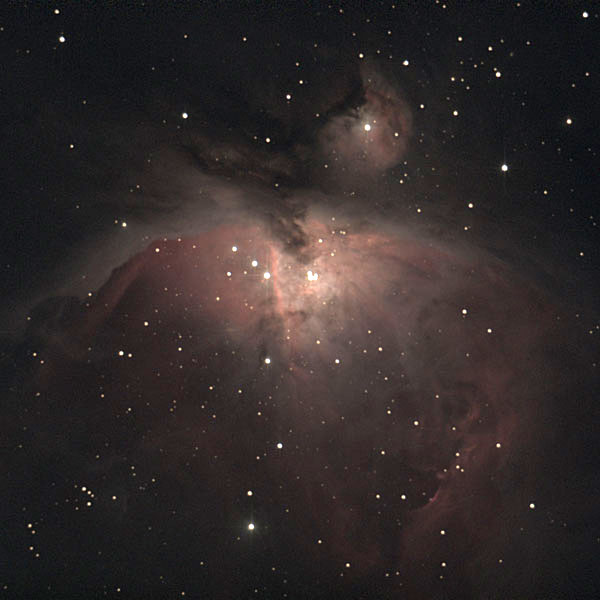 |
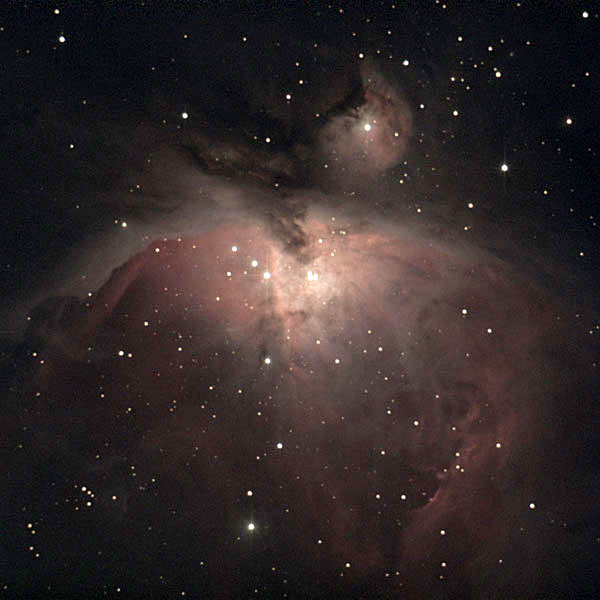 |
||
M 35 (Gemini) |
M 42 (Orion), processed |
M 42 (Orion), alternative processing |
||
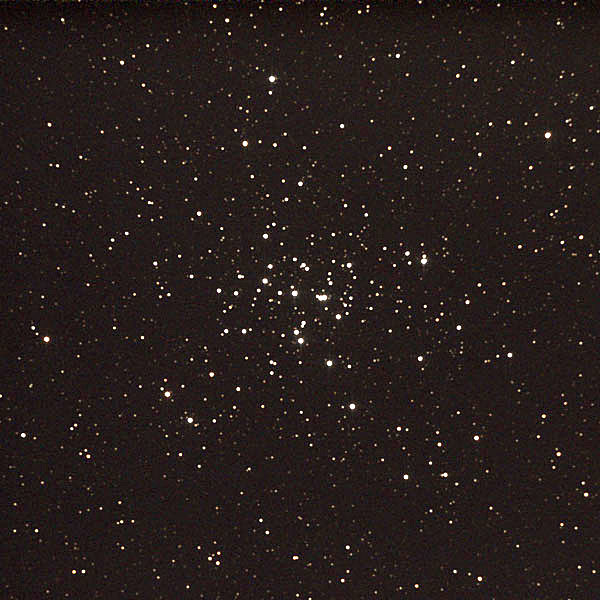 |
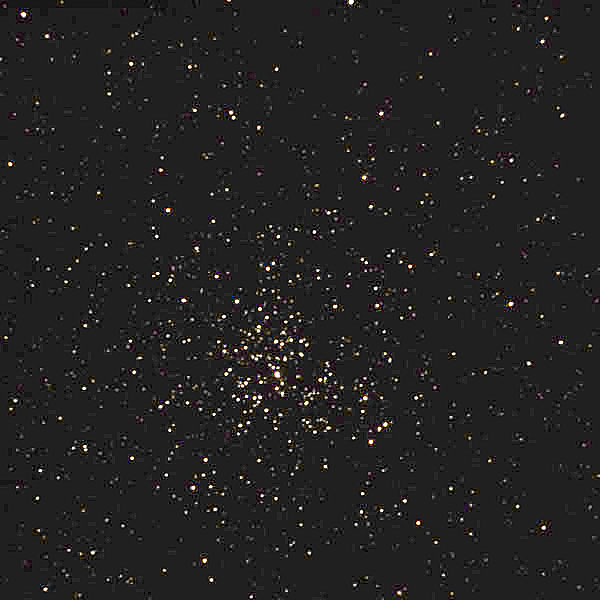 |
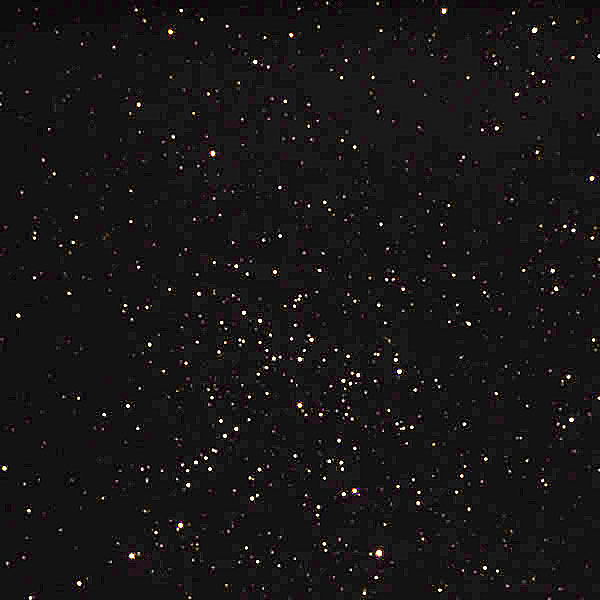 |
||
M 36 (Auriga) |
M 37 (Auriga) |
M 38 (Auriga) |
Attempts on February 21, 2018
The following photos were taken with the Explorer 150PDS on the Star Discovery AZ GoTo mount (with StarSense module):
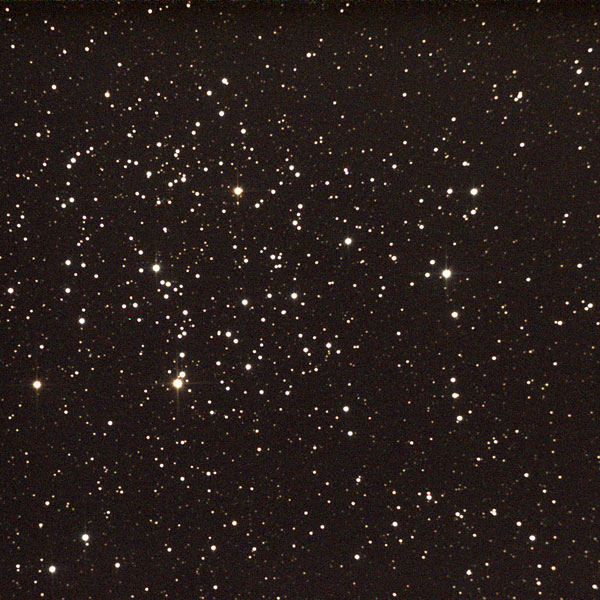 |
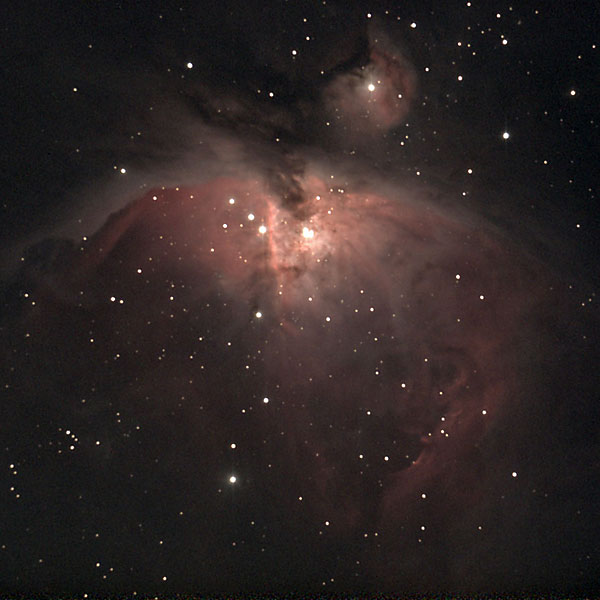 |
 |
||
M 35 (Gemini) |
M 42/43 |
M 42/43, alternative processing |
||
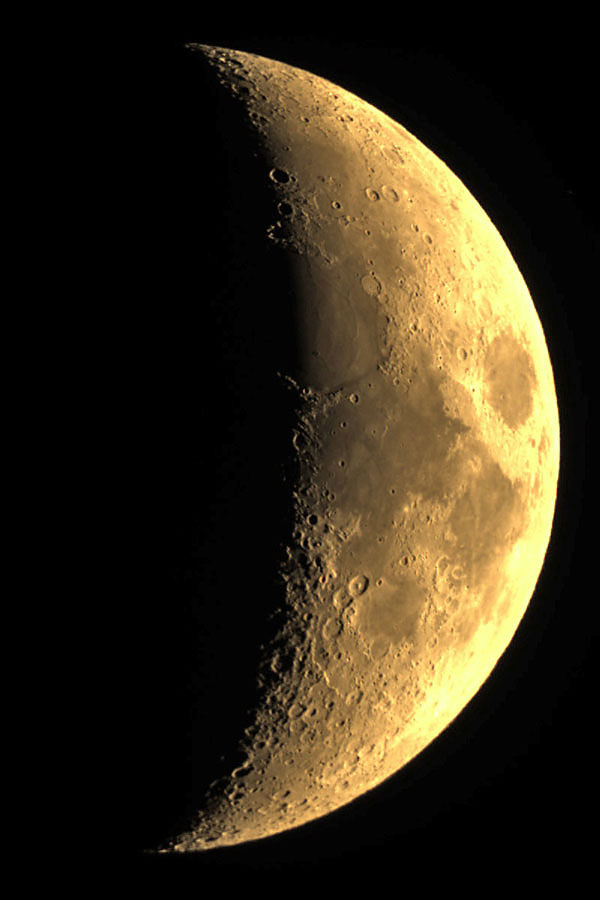 |
||||
Nearly Half Moon |
|
|
Later Observations
Note: See page Atik Infinity Colour Camera - Further Experiences (Nightly Tests) for later observations with the Atik Infinity.
Early Conclusions
Heritage 100P
As a "minimal info" I can pass on that I cannot directly use the
Atik Infinity camera at my Heritage 100P, because the camera does not come
into focus, that is, it delivers only blurry images. However, with a Barlow
lens or a focal length extender, the focus point can be moved
in the desired direction, namely outwards. Depending on the magnification
factor (1.5 x, 2 x or 3 x), the focal length is extended accordingly, which
might be quite an advantage. But this also reduces the aperture ratio, thus
requiring longer exposure times. The results achieved with the Heritage 100P
with a focal length extender can, however, only be called "poor"...
Update: I do no longer own the Heritage 100P.
Explorer 150PDS
The camera can be used directly at the Explorer 150PDS, and the achieved
results are also much better than those achieved with the Heritage 100P. With
appropriate post-processing, they seem to be no longer far away from what can
be achieved with my equipment - they are also, at least in part, comparable
to those of the eVscope.
Update: I do no longer own the Explorer 150PDS.
Skymax-127, Skymax-102 / C5, C8
Now it is all about detail improvements and
trying out the camera with other telescopes. I tested the camera already briefly
with the Skymax-127 and a 2 x focal reducer plus extension tube. Further tests
are needed, als well as tests with the Skymax-102.
Update: I do no longer own the Skymax-102 and Skymax-127. I also decided not to use the camera at my Maks. Later, I used the camera at my C8 and C5 instead.
A First Statement... / A Later Statement
Even with the initial poor results, I was already able to "see" more objects with the camera than I was previously able to find purely visually. In that sense, I was already satisfied with the camera from the beginning.
In the end, the photos were not really satisfying for me, except for those of the Orion Nebula M 42. Maybe, the camera needs longer exposure times than an AZ mount allows.
Positive Aspects of "Quick-and-Dirty Astronomy Photography"
I would also like to point out a few more positive aspects of "quick-and-dirty astronomy photography," which apply to "sub-optimal" photos in general, as well. Firstly, I can "see" objects with the camera, which I am not able to find for a number of reasons when observing visually. Even though the telescope tube was sitting on the GoTo mount, I was often not able to find some of the objects when observing visually, assuming that the objects were (mostly) correctly accessed. Thus, the camera can lead to the feeling of small successes, instead of frustration and disappointment.
Secondly, I can use the camera to save an image of the observed sky object, which at least, helps me afterwards to identify it, in the case that I am not quite sure that I actually have found it. And the image also shows certain object features that I normally cannot remember and quickly forget after observing. Later, you can find something like "a faint glow" or "nice" in my notes, which tells you close to nothing. Even a tiny and blurry photo contains more information that I can use in my recordings than such "overall" remarks.
Note: Over Christmas 2022, I sold my Atik Infinity camera (transferred on January 5, 2023). I therefore cannot report any further experiences with it here. |
Links
- Atik company Website, UK: www.atik-cameras.com
- Product page: www.atik-cameras.com/product/atik-infinity/
- Pages from German distributors for the Atik Infinity camera:
- Teleskop-Leasing (bought the camera here): www.teleskop-leasing.de/produkte/kameras/atik-infinity-farb-ccd-kamera- (in German)
- Teleskop-Spezialisten: www.teleskop-spezialisten.de/shop/Astrofotografie/Atik-Infinity-FARB-CCD-Kamera-11mm-Sensor-automatische-Aufnahmen::2166.html (in German) - www.teleskop-spezialisten.de/shop/Astrophotography/::2166.html (in English)
- Teleskop-Service/Express: www.teleskop-express.de/shop/product_info.php/info/p8213_Atik-Infinity-FARB-CCD-Kamera---Sensor-D-11-mm--vollautomatisch.html (in German) - www.teleskop-express.de/shop/product_info.php/info/p8212_Atik-Infinity-B-W-CCD-Camera---Sensor-D-11-mm--fully-automatic.html (in English)
- Astroshop: www.astroshop.de/kameras/atik-kamera-infinity-color/p,4831 (in German) - www.astroshop.eu/cameras/atik-camera-infinity-color/p,48316 (in English)
- Testing the 16 bit Atik Infinity camera with small telescopes (x-bit-astro-imaging, S.J. Wainwright): x-bit-astro-imaging.blogspot.de/2016/02/testing-16-bit-atik-infinity-camera.html
- ICX825 Based Astro-Video Camera Comparison (Jim Thompson): karmalimbo.com/aro/reports/Test%20Report%20-%20825%20Sensor%20Camera%20Comparison_07Oct2016.pdf
- Bis zur Unendlichkeit…. (Perter Oden, Peters Astroblog): videoastronomie.net/bis-zur-unendlichkeit (in German)
- Peter Oden: Videoastronomie: Der Himmel live und in Farbe. Sterne und Weltraum, Juni 2017. (in German)
- Electronically Assisted Astronomy with Atik Infinity (Fallenangel/Franz Müller): fallenangels2ndlife.dyndns.org/2017/03/01/electronically-assisted-astronomy-wit-atik-infinity/
- Einfach und schnell fotografieren mit der Atik Infinity (Sample photos, Peter Weigel, Teleskope Weigel): www.zudensternen.de/Atik_Infinity.html
- Review of the Atik Infinity Color Video Astronomy Camera (astrojedi, Live Astronomy blog): videoastronomy.blogspot.de/2016/02/review-of-atik-infinity-color-video.html
- Sony product information for sensor ICX825ALA/AQA: www.sony-semicon.co.jp/products_en/new_pro/may_2014/icx825_e.html
- Sky-Watcher Heritage 100P Information (4" Dobson)
- Sky-Watcher Explorer 150PDS Information (6" Newton)
- Sky-Watcher Skymax-127 OTA Information (5" Maksutov-Cassegrain)
- Sky-Watcher Star Discovery AZ GoTo Mount Information
- See also my page offering Astronomy Links.
Appendix: Data of the Atik Infinity Camera
- Sensor Type: CCD - Sony ICX825
- Horizontal Resolution: 1392 pixels
- Vertical Resolution: 1040 pixels
- Pixel Size: 6.45 µm x 6.45 µm
- ADC: 16 bit
- Readout Noise: 6e- typical value
- Gain Factor: 0.37e-/ADU
- Full Well: ~24,000e-
- Speed: 2-3 frames per second
- Interface: USB 2.0 High Speed and ST4 compatible guide port
- Power: 12V DC 1A
- Maximum Exposure Length: 120 s
- Minimum Exposure Length: 1/1000 s
- Cooling: Passive
- Weight: approx. 340 gr
- Backfocus: 13 mm
- Available as mono or color version (see the respective discussion on the Atik Website)
| 14.03.2025 |
